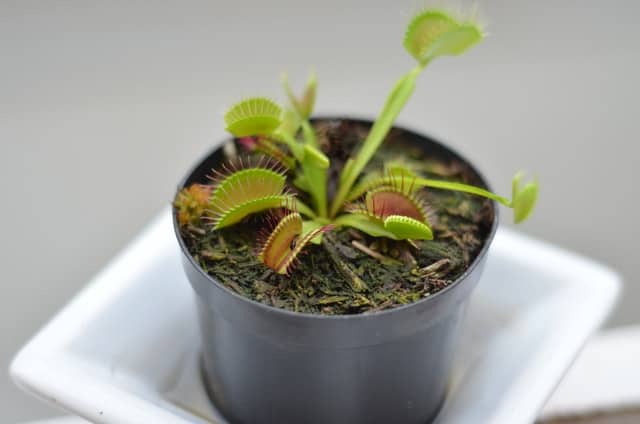Due to their popularity, Venus flytraps are grown all over the world. Some areas tend to be better suited for growing Venus flytraps. This article evaluates the main considerations when growing Venus flytraps in India.
Venus flytraps can be grown in India. The tropical climate provides acceptable temperatures and humidity levels to grow these plants. The main challenge of growing Venus flytraps in India is dormancy.
It is possible to grow Venus flytraps in India successfully. But, since India is not their natural habitat, Venus flytraps require specific care. In this article, I will share all you need to know to grow Venus flytraps in India.
Growing Venus Flytraps in India
When growing any plant, the main goal is to mimic the plant’s natural habitat. Venus flytraps do not grow naturally in India. Venus flytraps are native to only a small region in the United States.
Venus flytraps grow natively in North Carolina and South Carolina on the East coast of the United States. Venus flytraps grow with lots of sunlight, plenty of water, nutrition-less and slightly acidic soil, and access to bugs in that region. Also, humidity is high year-round.
The temperature in the area ranges from freezing temperatures (20 – 32 F) in the winter to hot and humid summers, with temperatures climbing until the high 90s. The cool temperatures during the winter are crucial for Venus flytraps, as they are necessary for dormancy.
Venus flytraps are resilient plants; they can adapt to different environments. Since most of India’s cities provide sunny and humid climates, it is possible to grow Venus flytraps there. Still, there are a few challenges:
- Venus flytraps require a dormancy period.
- Extremely high temperatures can dry up and kill Venus flytraps.
The next two sections will expand on how to overcome these two major challenges.
Venus Flytrap Dormancy in India
In the wild, Venus flytraps are exposed to cold temperatures during the winter. Every year, during such season, Venus flytraps experience a crucial period: dormancy.
Venus flytrap dormancy is similar to hibernation. When temperatures drop, Venus flytraps enter a dormant state. They lose many of their leaves and rest for several months.
To achieve dormancy, Venus flytraps need exposure to temperatures below 45 F (7 C) for several weeks. Then, the temperatures must remain cool for at least 2-3 months.
The dormancy period is critical for Venus flytrap; they must undergo dormancy every year. Without dormancy, Venus flytraps die after a couple of years.
Most of India characterizes by a tropical climate; the temperatures rarely drop below 45 F (7 C). Without cold temperatures, it is impossible to achieve dormancy naturally.
Regions in northern India have cold winters, which can be perfect for Venus flytrap dormancy. Cities like Shimla, Srinagar, and Mukteswar can provide the appropriate climate for winter dormancy. During that period, place Venus flytraps outdoors or indoors in cold locations. Venus flytraps enter dormancy after 3-4 weeks of exposure to cold temperatures.
If you live in a tropical area within India, like, for example, the cities of Mumbai, Delhi, or Bangalore, natural dormancy is not an option. In that case, you have two options:
- Skip dormancy, and expect your plant to live only a couple of years.
- Attempt refrigerator dormancy.
Many people opt for the first option, as they are unsure how long they would like to care for their Venus flytrap. Owning a Venus flytrap for a couple of years is enough for many people.
If you are looking to keep your plant alive for many years (even decades), it is time to evaluate an alternate option. You can induce dormancy by placing Venus flytraps in the fridge. There are certain steps you need to follow to complete this process. You can watch this video to learn the details:
Refrigerator dormancy will provide the same benefits for your Venus flytrap as natural dormancy. It can be more challenging, but it will keep your plant healthy.
Growing Venus Flytraps in Hot Temperatures
Venus flytraps can withstand a wide range of temperatures. They adapt to cold or hot climates, as well as dry environments.
Venus flytraps can withstand high temperatures of up to 95 F (35 C) and cold temperatures close to freezing 32 F (0 C). Growing in India, Venus flytraps can withstand the winter temperatures in almost any location. However, summers can be a challenge.
Some Indian cities are characterized by hot summer with temperatures exceeding 95 F (35 C) for several weeks. Venus flytraps can withstand hot temperatures, but it might be necessary to take extra precautions for the hottest summer days. Here is some advice to keep your plants healthy during the summer months:
- Avoid placing Venus flytraps behind glass: sunny windows can get extremely hot during the summer. The glass intensifies the light and can generate extreme heat. Instead, place the plant under direct or indirect sunlight, without glass in the middle.
- Always water your plant: Venus flytraps need plenty of water and humidity. During the summer, be consistent watering your plant to avoid any heat damage.
- Consider indirect lighting: Venus flytraps thrive in sunny locations, but scorching direct sunlight can kill them. Consider placing the plants in a location where it gets a few hours of direct sunlight and several hours of indirect light.
- Employ insulating pots: Pots made out of plastic or styrofoam are effective insulators. They prevent overheating during the summer and freezing during winters.
- Grow Venus flytraps indoors: With the appropriate lighting, Venus flytraps can be grown indoors and away from extreme temperatures.
Finally, there is one more tip I would like to share to keep your plants healthy in hot temperatures: Employ the water tray method. This is how it works…
When watering Venus flytraps, water them from the bottom. Place the plant pot in a tray. Then, fill up the tray to up to 1 inch in depth. Usually, the best strategy is to let the tray dry out and immediately fill up until the 1-inch mark. But, during the summer, I like to keep the trays always full. Because I am aware of the extreme outdoor temperatures, I prefer to provide more water and ensure the plant never dries out.

Venus Flytrap Care for India (tropical climate)
In this section, I have included specific instructions and advice to care for Venus flytraps. Some items contain specific comments to grow Venus Flytraps in India; others are more general but contain equally important information.
- Light: Venus Flytraps require lots of light. They can grow under partial or direct sunlight. But the minimum daily requirement is six hours. In most cities of India, the sunlight requirement shouldn’t be an issue for outdoor growing. The light source can be sunlight or artificial lighting. Indoor lighting can be equally effective if it is set up properly.
- Watering: Only water Venus flytraps with rainwater, distilled water, or reverse osmosis water. Water frequently to keep the soil moist at all times but not saturated. Never flood the soil.
- Soil requirements: Only employ nutrient-free carnivorous plant soil. A combination of pure sphagnum moss or peat moss with silica sand or perlite are suitable options. You can buy these ingredients in most gardening stores.
- Temperature: Temperatures in India are appropriate for Venus flytraps. Venus flytraps can withstand high temperatures of up to 95 F and cold temperatures close to freezing 32 F (0 C).
- Feeding: Place venus flytraps outdoors, where they can have plenty of access to feed. For indoor plants, consider feeding them to promote their growth. The feeding process can be tricky. But this article gives you all the details: How to Feed a Venus Flytrap – a Complete Guide With Pictures.
- Dormancy: Venus flytraps go dormant during the winter for 2-3 months. Check the previous section on dormancy in India. It contains the options you have depending on your specific region.
- Humidity: Venus flytraps can adapt to arid climates, but they benefit from high humidity environments.
- Repotting: Repot Venus flytraps once a year.
- Fertilizers: Do not employ fertilizers.
- Trimming: Cut leaves when they turn black by cutting them from the base.
- Terrariums: Venus flytraps can grow in a terrarium, but they are not necessary.
Would you like to download a free Venus flytrap care sheet? You are in luck! I have made a Venus flytrap care sheet summary for you. Feel free to download it from this article: Venus Flytrap Ultimate Care Guide. It is a free direct download. I hope it helps you grow big and healthy Venus flytraps.


